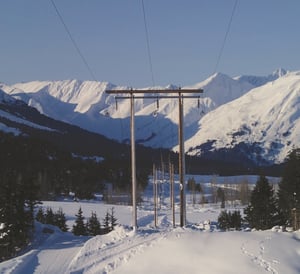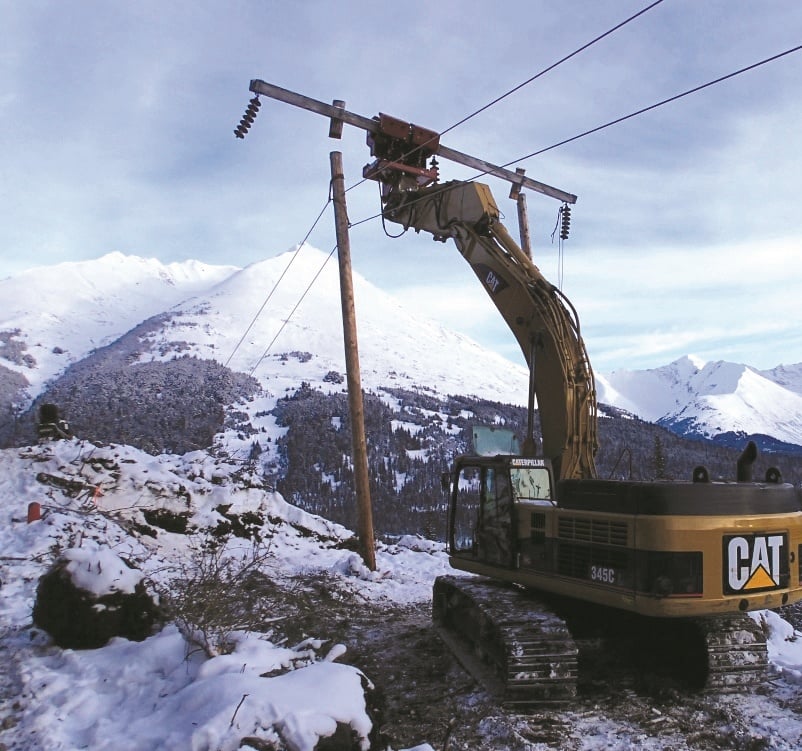The Quartz Creek line is 90-miles long and is operated by the state’s largest electric utility — Chugach Electric Association, based in Anchorage, Alaska. Shawn Wendling, senior project manager, explains the situation. “The line was originally built in 1962 to connect the Cooper Lake Dam to the rail-belt. In 1991, the state brought online the substantially larger Bradley Lake Hydro Project, which also uses the line. The Quartz Creek line is critical because it is the only transmission line connecting the two dams to the rail-belt and because that generation is our cheapest source of power. It is also important because we use our hydro resources to adjust for system variances, so that gas consumption at our combustion turbines stay on schedule.” ®
The line and its structures are now over 50 years old and the cooperative keeps an eye on structure integrity. In 2007, Chugach performed a detailed helicopter survey, which revealed some deterioration of the wooden, H-frame towers. The cooperative then verified the damage with a climbing survey. “During the summer of 2008, we sent crews down the right-of-way and tested the arms and poles. About 50% of the poles surveyed showed signs of rot,” explains Wendling.
Although in need of repair, the towers were still intact. “Interestingly, in the winter of 2011-2012, before we started working on the line, we had a very bad winter. In total, over 11 feet of snow fell in Anchorage, but, I’ve got to say, in the mountains we got more than that. We had structures bent over like a fishing rod with a King Salmon on the end, but they held despite the deterioration. It is a testimony to the quality of wood we used back in the day— clear, good grained, old-growth wood. That winter, we lost one arm and one pole—that was it,” mentions Wendling.
CAREFUL PLANNING
Knowing that a substantial amount of work needed to be done, the cooperative divided the project into immediate and long-term repairs. In 2008 and 2009, Chugach operations personnel addressed a list of critical jobs to ensure short-term reliability. During that same period, planning and engineering identified and prioritized the line sections that were in the worst shape.
The first goal was to replace the most critical, 15-mile section, which happened to cross through the toughest terrain. (The 90-mile line crosses a mountain range, bends around a body of water, jumps back through the Chugach Mountains, to find its way to Anchorage.)
In Alaska, public funding is available at times to help mitigate the cost of rebuilding critical electrical infrastructure, but the process to obtain public funding is indeterminate. In some cases, funding is obtained in a calendar year. In this case, funding for the Quartz Creek rebuild was a two-year effort. Chugach got the money in July of 2011 and immediately began the permitting and design process.
Even at this stage, the cooperative knew that the work would have to be performed during the winter months, when snow roads could be built. (Snow roads mitigate environmental impact and provide access.) It was clear from the beginning that the rebuild was going to be challenging.
Wendling points out, “As the project engineer, the first things that come to mind for any project are design, permitting, and materials delivery. I asked myself, which is going to take longer? In this case, we started the permitting early and the design wasn’t too complicated. But make no mistake, because we are on the far end of the world, supply chain logistics never fall far from our gaze.”
PERMITTING AND RECREATION
Overall, permitting took about a year. The State Department of Natural Resources controls a little over a third of the land. The US Forest Service controls the rest.
“You could say the whole right-of-way is an environmentally sensitive area, but the main challenge was recreational use. The middle five miles of the project are in one of the prime winter recreation areas for South Central Alaska. One side of the road is used by snow machines and the other side offers exceptional, backcountry skiing. There were a lot of recreational users out there, who ‘recreated’ right where we needed to be working. So, there were a lot of stakeholders to respond to and bring into the process,” says Wendling.
A large portion of the project’s success can be directly tied to Alcan Electric and Engineering, Inc. in Anchorage, AK—the company that built the line. Alcan’s communication and outreach efforts to the various recreational user groups were extremely helpful.
THOUGHTFUL DESIGN
On the positive side, the lengthy permit process provided ample time for Chugach to carefully plan and design the new towers. The cooperative worked with a local design firm Dryden & LaRue, Inc. (D&L), Anchorage, AK.
Since a long-term planning study called for the transmission line to be at 230-kV instead of the existing 115-kV, the line was rebuilt and insulated for 230-kV. Also, considering recent record snow falls, some towers were significantly increased in height. “We added between eight and 20-feet, where needed, to provide increased clearance during heavy snow falls. Before construction, the average height of the structures in this section was 65 feet. It is now approximately 95 feet,” reports Wendling. To limit structure weight, about a third of the wooden structures were replaced with steel.
Wendling explains, “We wanted to make sure this project could be built using helicopters, if necessary. The biggest wood poles needed could weigh as much as 9,000 or 10,000 pounds. So, we substituted steel poles. As it turned out, Alcan Electric did not use a helicopter. Because of the substantial snowfall during the winter 2012-2013, Alacan was able to build roads and drag in the materials.”
Crews started, cleared and staged on November 6, 2012, and re-energized the line on April 16, 2013.
Which brings us to TowerPak® Kits. The cooperative broke the project into four purchases: conductor, wood poles, steel poles, and line hardware. The first three were commodities and arrived in three big shipments. For example, the 168 wooden poles that arrived by rail (close to the site), were trucked to the work zone and staged along the way.
The fourth purchase order was different.
“I thought it would be great if all the other parts and pieces could be delivered in one shipment, already kitted. We’re talking about specific insulators and hardware. In some cases, we are talking about hardware that was manufactured especially for the project. I wanted to find a way to get all the parts delivered conveniently and efficiently,” explains Wendling.
Wendling remembered an article about TowerPak in Hubbell’s Tips and News magazine. “I dug into it a little bit more and found out that TowerPak isn’t usually applied to projects as technically simple as the one we were embarking on. There was some skepticism at the co-op as well, because we’d never done anything like it before. I wanted to make sure that I understood it, so I went out and talked to a number of suppliers and other wholesalers who do kitting. Hubbell was the only manufacturer I found that did it. Some of the wholesalers I approached didn’t think this project was big enough for them to bother with. Regardless, we put together a spec to containerize all the pieces (the insulators, hanging hardware, and the connecting hardware) we thought we would need on each structure.”
Wendling asked that all parts be put in sealed boxes that would hold up to the weather and be durable. In the end, Hubbell was the low bidder through their suppliers in Anchorage: Potelcom and WESCO. The cooperative placed the order in October of 2013 for delivery by the end of the year. Despite a big winter storm hitting the East Coast of the Lower 48, everything was delivered on time.
“I wanted to streamline the shipping, because shipping things from anywhere to Alaska is an opportunity for something to get lost. Things get lost during shipping. Parts get sent to the wrong destination—like Alabama (AL) instead of Alaska (AK). Or the delivery misses the barge. Or, the shipper has never come this way and isn’t familiar with road conditions, permitting requirements, and clearances. If you were to ask me how many ways things can go wrong…I don’t think I have enough fingers and toes to count them,” says Wendling
“So, I wanted to mitigate the shipping risk by dealing with one supplier that could really put everything together in one consolidated shipment.”
Then there is the snow.
This project took place in a mountain pass in the middle of winter, where storms routinely dump one to two feet of snow on the ground. “Looking for anything in a foot of snow is difficult. It is the proverbial needle in a haystack. Remember, a foot or two of snow is deep enough to hide a 2’ x 2’ cardboard box. Further, cardboard boxes get wet and fall apart and once a part is out of whatever container it came in, then you’re in trouble,” warns Wendling.
TowerPak solved that problem as well. Chugach received 112 TowerPak Kits — one box per tower and a few extra. None disappeared into the snow. As a result, the work finished ahead of schedule, with no equipment lost.
Special thanks to Shawn Wendling, Senior Project Manager, Chugach Electric.


 While not a technically challenging project, Hubbell Power Systems'
While not a technically challenging project, Hubbell Power Systems' 




